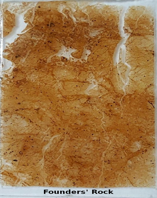3
UC Berkeley’s lore has it that the campus and by default the entire University of California system was founded on April 16th, 1860, at this unique rock outcrop now hidden under trees and behind bushes at the corner of Hearst Avenue and Gayley Road. Never mind that the actual founding of the University happened on March 23rd, 1868, when then Governor Henry Haight signed into law the Charter Act, which the State Assembly had passed a few weeks earlier. And also ignore that the commemorative plaque inserted into the rock does not mention UC Berkeley at all but one of its predecessors, the College of California. Nevertheless, this location is special to the University, being the highest point above sea level in the northeast corner of the original campus. The view across campus and over the San Francisco Bay must have been spectacular before Cory Hall was built in 1950 obstructing the overlook. And the oddly shaped outcrop itself is definitely worthy of being called Founders’ Rock.

While its north and east sides are thickly covered with moss and lichen, the west side reveals the rock’s origin. It is a reddish volcanic rock very rich in silica. Such rocks with high silica content are called rhyolite. Looking at it from up close it seems to be volcanic ash baked together with small fragments of other volcanic material. These two observations make Founders’ Rock a “volcanoclastic welded tuff” with rhyolitic composition.
But where does this strange outcrop come from, when there is no volcano in sight anywhere on campus? One plausible hypothesis is based on the fact that Founders’ Rock is very similar to a rock type from the Jurassic period, which was quarried for decades in the Leona Quarry at the upper end of Hegenberger Road in Oakland, the so-called Leona rhyolite. The tectonic movement of the Hayward Fault, so the hypothesis goes, carried the rock to its current location almost 10 miles northwest of the quarry. It this is true, then Founders’ Rock formed when dinosaurs still roamed the planet, which predates the founding of the University by a mere 150 million years.
Confirming this hypothesis, however, is not that easy. Figure 3.2 shows what geologists call a “thin section” of a small piece of Founders’ Rock. It is less than a tenth of an inch thick and molded into clear plastic, so that light can shine through it. The section reveals the reddish color of the rock, but also shows clear veins which are filled with mineral called calcite. When the author of this guide asked Paul Renne, the Director of the Berkeley Geochronolgy Center, to determine the age of this rock, he responded: “This rock has a tortured history. It is completely recrystallized and metasomatized, to the point that I can’t tell what kind of rock it was originally. It may have undergone major deformation and brittle shear but the texture is so heavily overprinted with carbonate and other secondary minerals that even this is hard to say.” It seems that for right now Founders’ Rock shall remain an enigma.

Walk southeast on Gayley Road until you reach the intersection with Stadium Rim Way, where you turn left. Walk uphill to the end of the parking garage under the Maxwell Family Field across from Bowles Hall. Turn right at the stop sign there and walk towards the stadium. At the end of the parking row on your left an asphalted walkway leads gently uphill. Get on this walkway. Just before you reach to top of the walkway, you’ll see a concrete box with a steel lid on your right. This is our stop 4 in figure 2.
